Badly worn dentures.
This case explains what changes, need to be considered prior to manufacturer. As you will note the changes in the mouth mechanically are quite severe, yet to the wearer the changes are gradual and therefore unnoticable. Unfortunately this side shift in the lower jaw has taken the back teeth completely away from their correct position. The task we have now is to convince the client the amount of change that is going to take place in order to place the two jaws correctly together.
So the task now is to try and help the client to understand that change is inevitable and is unfortunately unavoidable. In order to proceed with a case like this we need to build the patients confidence so with photographs of what is present in their mouth is clearly translated to them, so that hopefuly they will agree with our diagnosis.
I consider that 'Patients Confidence' in my ability is ultimately thee most important aspect of supplying successful dentures. I consider communication being the 'key' criteria and one of the principles of cooperation during the process.
Indeed 'Patient Cooperation' can be severely tested in certain interview situations no more than the client who has had the same dentures for more years than they care to remember (40 to 50 years, are not unusual)
Following an oral inspection with the dentures in place I find that for years they have been accomodating badly worn dentures of which the musco-skeletal structures have adjusted to accomodate the wear. This accomodation can in certain situations have a deteriorating effect on the soft and hard supporting structures including the joints near the ears .
Case Study
Mrs C R. 69 years of age lady attended requesting a full set of replacement dentures very similar to the set on the right Fig1. which have been successful up untill 3 months ago when they started to go loose. The dentures had in actual fact been uncontrollable for a number of years. However the family had started going out for meals and she was generally the last one to finish the main course if not abandon it for the easier chewable dessert course.
Fig 1 diagram on the right illustrates the presented denture teeth, badly worn. The dentures were approx, 35 years old.The client requested a new set of dentures but didnt want them to feel different to her present dentures. These were the only dentures she owned.
The two vertical thin blue lines between the upper and lower cental incisors should, if correct, be vertically continuous. However, the photograph illustrates the deviation from the correct position to the right by 2.7mm. This was due to severe posterior teeth wear.
Fig 2 &3, Illuatrates the static relationship of tooth contact at the back of the mouth. You can compare them with fig 5&6 to see how they should be.
Fractured Dentures
Worn dentures like these used for chewing and grinding are highly prone to fracture. The reason is that the client has to apply more pressure and more 'functional rotations' over a longer period on the food in order for successful mastication to allow swallowing to occur. These people can not indulge in verbal communication with their fellow accompanying table colleagues as they are concentrating on chewing.
On the patients left side fig 2, the only area available for chewing was on the very back teeth which pressed on the lower denture causing it to move forward under chewing pressure. This resulted in the lower denture moving downwards and forward rubbing the gums as it went creating discomfort.
As you will note in fig 2, the left front incisor teeth were out of contact and therefore inadequate as cutting teeth.
On the right side fig 3, none of the back teeth were in contact, with the lower front teeth in front of the upper front teeth.
This means that every time this patient closed together to cut food they had no balance from the back of the mouth. The lower denture would be forced forward as the upper incisors closed behind the lower incisor teeth. Thus by analysing the single tooth contact we are able to deduce that the lower denture was moved forward to the right by the right upper front teeth and the left side back teeth pushing the denture in the same direction. The gums were sore in the corresponding areas under the lower denture.
Question. How did this patient chew and grind food?
Answer. With what I call 'Oral Acrobatics', a mixture of tongue pressure on the inside with balancing pressure from the lips and cheeks on the outside.
The lower jaw being displaced forward and to the right untill the back teeth eventually touched.
Unfortunately, this situation over a number of years resulted in chewing taking place with the joints near the ears being outside their normal parameter and subsequesnt clicking with sideways movements resulted, also when the jaw was open and closed.
When questioned about the jaw clicking she never associated it to the fault of the dentures being badly worn but to the fact of her age.
Following a careful interview and explanation of what had caused her problems and the fact that she would have to get accustomed to new dentures as the change was going to be more drastic than if she had had them replaced twenty years ago.
I likewise impressed on her the importance of regular denture check ups and the importance of selecting high quality hard wearing denture teeth as these would maintain her lower jaw in the correct position and maintain good long lasting chewing ability.
She agreed to my advice and selected Vivadent PE shade 01, a truly beautiful denture tooth.
And so the new set is illustrated on the right in fig 4.
The slow deterioration of chewing function is difficult for patients to appreciate untill somebody notices the difficulty in eating or from a denture inspection.
When eventually they compare the new replacement dentures the look on their faces is one of shock, horror and surprise. In many cases they apologise to me for not changing them earlier or commenting to their accompanying relations. Why didnt they tell them about their change in appearance!
The change is so slow it can easily be mistaken as a change in facial appearance due to maturing age.
In severe cases it can literally take years of their appearance and make them look ten years younger. That's my opinion, but I never advertise the fact as it is up to the client to make that decision for themselves, not me.
Overclosure of the lower jaw upwards is also associated with the chin protruding forwards as the jaw hinges from in front of the ears. This movement towards the nose creates deep horizontal folds at the corners of the mouth.
The 'squashed face' results with a small lower jaw appearance and a alteration in speech pronounciation. This is chiefly due to the restriction in tongue movement associated with cubic area reduction in tongue space allocation. Symptoms of which can be spitting whilst speaking.
A further visible appearance is that of the upper front teeth can appear too far back with the upper lip looking chunky and creased horizontally, whilst the lower front teeth can appear too far forward.
The facial profile can also appear concave.with the middle third of the face appearing too far inwards.
Overopen this can often occur when dentists or CDT's are trying to ascertain the correct jaw relationship and with patients wishing to reduce the crease lines of ageing. Over opening symptoms are usually an acheing at the (temporal region) side of the head as the muscles are stretched all during the day. Relief is obtained when they at home by removing the lower denture.
Swallowing is difficult as in many cases they find it difficult to obtain competent lip function for swallowing. Speech and phonetic pronounciaton are likwise affected. Excessive amount of tooth visible in both the upper and lower jaws.
Their face takes on a stretched appearance with the lower eyes lid appearing lower down as the cheek muscles are stretched. Eating is generally impossible and uncomfortable. Dentures should be remade.
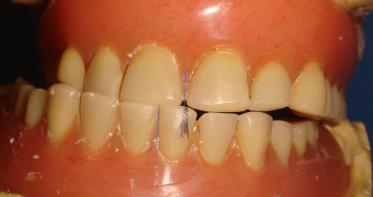
Fig1
Fig 1 depicts a situation were the posterior teeth are no longer supporting the upper and lower jaws in the correct centric position.
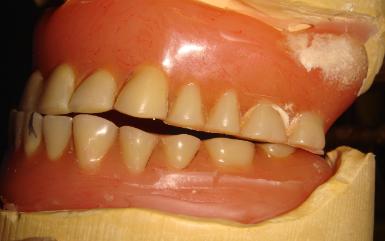
Fig2
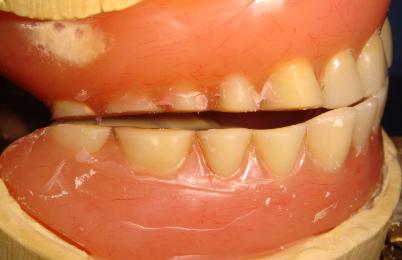
Fig3
These dentures are functionally inefficient. In many cases the client attends with fractures unaware they applying excessive pressure whilst trying to chew their food.
The excessive pressure applied to old plastic bases results in plastic fracture
MB Just as we can see the tooth surfaces don't fit together, the fitting surfaces are likewise seperated dur to jaw shrinkage. Again the cause of fracture.
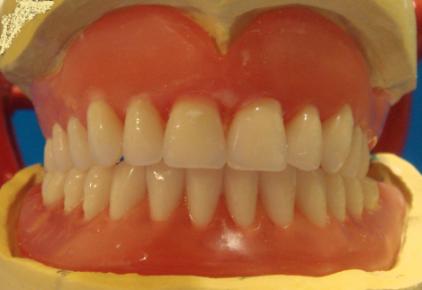
Fig 4
The finished full set of teeth prior to fitting
Fig 5
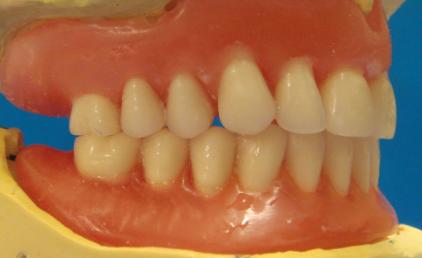
Fig 6